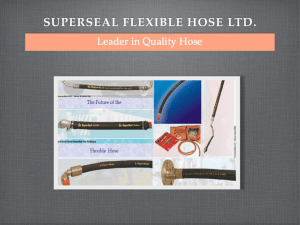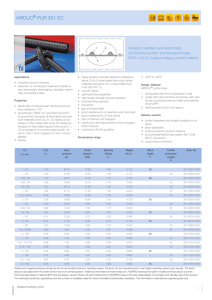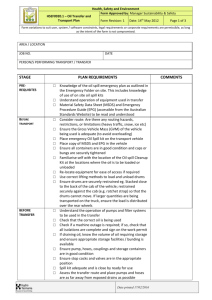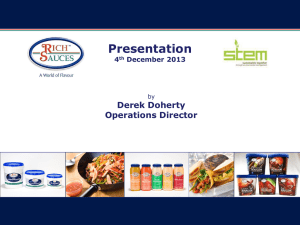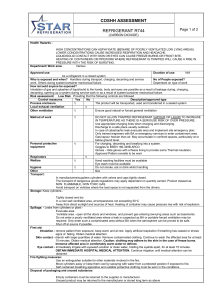Witzenmann Flexible Hoses for CO Air-Conditioning Systems of Vehicles
advertisement
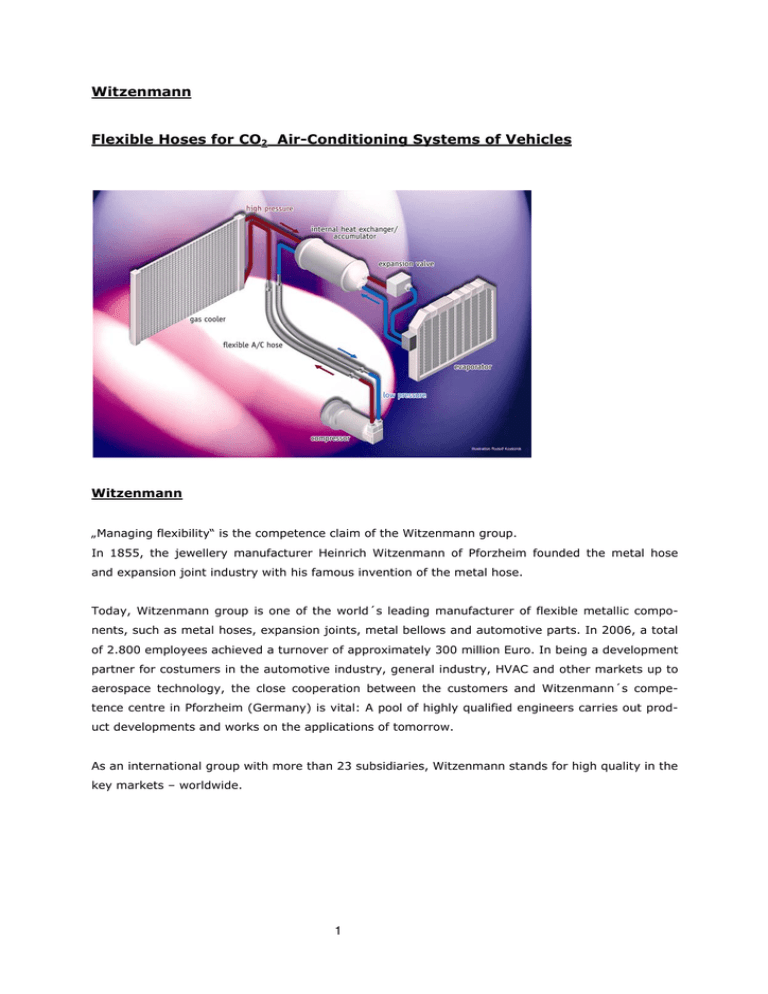
Witzenmann Flexible Hoses for CO2 Air-Conditioning Systems of Vehicles Witzenmann „Managing flexibility“ is the competence claim of the Witzenmann group. In 1855, the jewellery manufacturer Heinrich Witzenmann of Pforzheim founded the metal hose and expansion joint industry with his famous invention of the metal hose. Today, Witzenmann group is one of the world´s leading manufacturer of flexible metallic components, such as metal hoses, expansion joints, metal bellows and automotive parts. In 2006, a total of 2.800 employees achieved a turnover of approximately 300 million Euro. In being a development partner for costumers in the automotive industry, general industry, HVAC and other markets up to aerospace technology, the close cooperation between the customers and Witzenmann´s competence centre in Pforzheim (Germany) is vital: A pool of highly qualified engineers carries out product developments and works on the applications of tomorrow. As an international group with more than 23 subsidiaries, Witzenmann stands for high quality in the key markets – worldwide. 1 Flexible hoses for CO2 Air – Conditioning Systems of Vehicles Development The natural refrigerant CO2 (R744) protects the environment and increases the passenger comfort in the vehicle. However the route to serial production is arduous: Due to the media characteristics of CO2 it provides a couple of challenges for the components of the refrigerant loop. Redesigning R134a components is necessary and in certain cases, completely new developments are required. This article from Witzenmann describes the development of permeation tight air conditioning hoses for the CO2 A/C system. Flexible lines in the air – conditioning system For years, there has been a steady increase in the number of vehicles equipped with A/C systems. In 1990, only 12% of the European passenger cars had air-conditioning systems; in 2004, approximately 88% of the 3,3 million newly registered cars in Germany were equipped with mobile A/C. Most A/C components, for example the gas cooler or evaporator, are attached to the body. The compressor however is attached to the engine, as it is belt-driven like the other auxiliary engine parts. To compensate for the relative movements between the engine–fixed and body–fixed componentsof the A/C system, flexible connection lines are required. In R134 operated A/C systems, multi – layer rubber hoses are used. Their core material has a certain resistance against permeation of the refrigerant and refrigerator oil, see figure 1. figure 1: multi-layer rubber A/C hose (schematic) With this system, there is a certain refrigerant loss caused by permeation that is compensated by refilling the A/C system at regular service intervals. This is also the problematic under environmental aspects: The fluorocarbon R134 (CH2F-CF3) has a high global warming potential (GWP). This GWP is described on the basis of the natural gas carbon dioxide: 2 The GWP of R134a is 1300, i.e. the emission of one kilogram R134a has the same greenhouse effect as 1300 kilogram CO2 (referred to 100 years). The quantities of R134a that are emitted by permeation and disposal are contributing significantly to the greenhouse effect (average filling quantity approx. 0,7 kg/passenger car). The Kyoto protocol therefore classifies R134a as an unwanted substance. The European Union schedules the ban of R134a A/C systems from 2011 on for new platforms and a complete ban as from 2017. The refrigerant R744 (CO2) comes from natural sources or is a waste product in the chemical industry; as a result, it does not pollute the atmosphere. In comparison to R143a, the refrigerant R744 has better thermodynamic properties reducing the fuel consumption of the A/C system. Passenger comfort is increased due to better cooling characteristics. Therefore, R744 is an interesting environmentally beneficial alternative to the refrigerant R134a in mobile A/C systems of automobiles. Requirements for R744 A/C hoses When operating the A/C system with the refrigerant R744 (CO2), permeation is not an environmental issue, but it has to be avoided for functional reasons. To ensure an acceptable operating time until refill of the system, the current specification drafts ask for leakage rates of less than 1 gram CO2 per year. Additionally, CO2 has a high affinity to rubber surfaces, leading to a high solubility of the CO2 in the material itself. After sufficient exposure and consequently a sudden pressure release, the phenomenon of „explosive decompression“ may appear, as illustrated in figure 2. figure 2: Steps of an explosive decompression reaction As a result, the occurring pressure difference between the rubber and surrounding environment, the diffusing gas congregates in existing or newly developing hollows. This leads to the formation of bubbles which explode under massive expansion. To avoid explosive decompression in the R744 A/C loop, a diffusion – tight barrier in the flexible A/C hoses is necessary. In addition to the resistance against CO2 on the inside and an outside resistance against the possible common media in the engine compartment, there are many other requirements for flexible A/C hoses in a R744 A/C system. The significant differences between the refrigerants R744 and R134a result from their different thermodynamic properties: 3 As the heat emission of the R744 occurs in the supercritical state, the A/C system operates at a higher pressure level compared with the conventional R134a system, as shown in figure 3. figure 3: log p,h diagramm for R134a and R744 Therefore the flexible A/C hose has to be designed for higher maximum operating pressures (approx. 14 MPa); frequent on/off switching of the system over time additionally leads to significant pressure pulsations. Because of the environment and media conditions, the flexible A/C hoses have to withstand temperatures between -40°C and 180°C. The selected materials must exhibit a sufficient temperature resistance. The multiaxial relative movements with large amplitudes that have to be compensated by the flexible hoses are not dependent on the type of refrigerant. They are caused mainly by load changes and excitations due to poor road conditions (figure 4). figure 4: possible distortions of a R744 A/C hose To decouple the engine vibrations, the vehicle´s engine/transmission is elastically connected to the chassis via the engine mounts. With changing output torque, load changes lead to a typical engine pitching in vehicles with front wheel drive and an engine rolling in vehicles with rear wheel drive. In contrast, poor road excitations mainly result in irregular, mainly translational engine movements. 4 Both engine movements caused by load changes and those induced by poor road excitations lie below 20Hz. In vehicles with longitudinally mounted engines and rear wheel drive, the engine mounting is generally more rigid, resulting in smaller engine movements compared with vehicles with transverse engine and front wheel drive. The distortions of the flexible A/C hose are also dependent on the installation position. Especially the position of the hose relative to the pitch or roll axis has a significant influence on the size of the distortions resulting from load changes. Flexible A/C hoses also have the task to decouple the A/C lines from the engine and compressor vibrations (frequency range approx. 20 - 500 Hz). At an appropriate frequency, the engine/compressor vibrations could excite the natural frequency of the A/C lines, resulting in high amplitude resonances and a curtailment of the A/C lines’ operation life. The engine/compressor vibrations also could be transmitted via the mounts and then dispersed in the form of interior noise. To reduce these vibration amplitudes, flexible A/C hoses require low stiffness and increased damping capability. These characteristics increase comfort and reliability. Design of R744 A/C hoses The required permeation tightness against R744 requires a completely different design of R744 A/C hoses. Absolute zero – permeation and high temperature stability are provided by an annularly corrugated metal hose. It is made of austenitic stainless steel and has to be installed in a bent position to allow movement compensation in all directions. To resist the system pressure, pressure pulsations and vibrations, the metal hose is covered with a metal braiding, that is welded to the metal hose or A/C line. In certain cases, an intermediate layer between the two metal components, made of silicon rubber may be necessary. This layer prevents mechanical wear caused by relative movements between the metal hose and braiding. The R744 A/C hose then has a three – layer design, as shown in figure 5. figure 5: Assembly of R744 A/C hoses 5 The higher operating pressure level of the carbon dioxide results in a high volumetric capacity, enabling a 50% reduction of the hose diameters compared to R134a. An inner diameter of 6 mm on the high pressure side and 8 mm on the low pressure side lead to a very compact design (figure 6). figure 6: Comparison of the geometries of a R134a and a R744 A/C hose Ageing behaviour of R744 A/C hoses The ageing behaviour of conventional R134a hoses is dominated by the chemical characteristics of the rubber materials. Due to long – term continuing attacks of oxygen molecules in combination with a high temperature influence, the primary bonding may suffer from rupture and (re)formation processes. The resulting embrittlement combined with the system pressure and occurring movements are the limiting factors fort he operational life of rubber hoses. With the described R744 A/C hoses, the permeation tight layer and the pressure holding components are metallic; only the optional intermediate layer is made of heat stabilised silicon rubber. This material has outstanding ageing characteristics at maximum operating temperatures. The mechanical stresses are taken by the metallic components, so their contribution to ageing is considered negligible. In contrast to rubber hoses, the operational life of R744 A/C hoses is limited by material fatigue and corrosion of the metal hose and braiding. These damage mechanisms have to be regarded during the design and validation phase. Corrosion behaviour of R744 A/C The selected austenitic stainless steels exhibit an excellent resistance against the media on the inside of the R744 A/C hose, i.e. the refrigerant CO2 and the lubricating oils PAG or POE. Therefore no corrosion occurs on the internal surface of the hoses. However, as an operational life of 15 years or 300.000 kms is required, it is necessary to design resistance against outer corrosion, which is mainly caused by salty water. At operating temperatures between -40°C and 180°C, wet corrosion such as pitting and stress corrosion cracking is the dominant corrosion mechanism. 6 A sufficient resistance against wet corrosion is achieved by the use of austenitic stainless steels with high chromium, nickel and molybdenum content in the metal hose, braiding and connecting parts. The metallic components are connected with laser weld seams. This measure reduces the heat intake and improves the corrosion resistance in the joining area. Fatigue The main factor that limits the operational life of flexible R744 A/C hoses is fatigue; the metal hose and the braiding are the critical components. The fatigue results from the mechanical stresses caused by the internal pressure and the distortions of the hose. The operating pressure and the pressure pulsations are dependent on the thermodynamic characteristics of the refrigerant R744 and the operating conditions, e.g. ambient temperature and required cooling performance. Therefore the mechanical stresses caused by internal pressure are very similar for the different types of vehicles. The current requirements with respect to internal pressure and occurring pressure pulsations are available as single stage or multistage load spectrum. The validation of the hoses is carried out on a pressure impulse test rig (figure 7). figure 7: pressure impulse testing of R744 A/C hoses The internal metal hose is mechanically a double curved shell structure. The stress distribution caused by internal pressure is dominated by bending stresses in the meridional direction, as shown in figure 8. figure 8: Stress distribution in R744 A/C hoses 7 The most pronounced stresses occur in the inner and outer crests. The resistance against pressure pulsations is easily improved by increasing the hose's wall thickness or decreasing the metal hose formation ratio. However: Both measures decrease the resistance against distortion induced fatigue. Therefore, the geometry of the metal hose must be designed very carefully to the individual requirements, in order to meet a R744 AC hose that is optimised for cost and function. The distortions of the A/C hoses caused by the relative movements between the engine and chassis result mainly in a bending of the hase's axis. Considerable axial distortions are prevented by the axially stiff braiding. The distortion of the metal hose leads to a stress distribution comparable to the distribution caused by the internal pressure. Again, the stresses in the meridional direction are dominating. Therefore, operation of the A/C system leads to a superimposition of the stresses caused by internal pressure and distortion. As the pressure changes occur at a much slower rate than the distortions, the stresses caused by internal pressure can be treated as static mean stresses; the distortions cause dynamic stresses. As a result, current fatigue testing specifications allow a load cycle testing with static internal pressure. In general, the braiding exhibits the same behaviour as the metal hose, but the braid is more robust against fatigue. In contrast to the system pressure, the distortions of the flexible A/C hose are different for each vehicle. Therefore the determination of the operational loads is vital. For the assessment of the operational life, detailed knowledge of the time-related distortions of the flexible A/C hose in all six degrees of freedom is essential. During the early development phases, distortions of the A/C hose can be assessed using computational methods. The requirements usually follow the standard validation test program of the vehicle. For a sufficient resistance against fatigue caused by distortions, not only the corrugation geometry but also the flexible length of the A/C hose is a key factor. The flexible length therefore has to be tailored to the vehicle-specific distortions. The validation of the R744 A/C hoses on the component level is achieved using operational load testing. With this test, the pressure and distortions for the relevant driving manoeuvres can be realistically simulated. This requires fast multi-axis test rigs, see figure 9. figure 9: Operational load testing of R744 A/C hoses 8 The influence of the temperature and the fatigue behaviour is known due to extensive research on metal sheets and metal bellows. Therefore, the fatigue testing can be performed at ambient temperature, using diminution factors to compensate for the temperature influence on the number of load cycles or stresses applied. The contribution of dynamic stresses to the fatigue pattern is negligible, because the three-layer design of the flexible R744 A/C hoses provides significant inner damping. Outlook Air-conditioning of vehicles with R744 has a large potential for future applications. For safe and reliable operation, flexible A/C hoses are necessary. These hoses have to meet very challenging requirements with respect to permeation tightness and operational life. Based on long lasting knowledge and experience with the development and application of flexible metal hoses and bellows, Witzenmann has developed and tested a design for flexible R744 A/C hoses that meets the fundamental requirements. The prediction of the operational life apart from test rig validation is today in the major focus of Witzenmann. Authors: Dr. Bert Balmer Dr. Carlo Burkhardt Dipl.-Ing. Wolfgang Riemensperger 9
